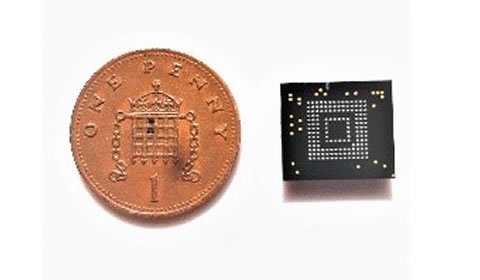Tech Talk
What is eMMC? (Embedded Multi-Media Card)

Last updated 7 May 2024
The term eMMC is short for “embedded Multi-Media Card” and refers to a package consisting of both flash memory and a flash memory controller integrated on the same silicon die. The eMMC solution consists of at least three components – the MMC (multimedia card) interface, the flash memory, and the flash memory controller – and is offered in an industry-standard BGA (Ball Grid Array, right) package.
Where is eMMC used?
Smaller than a typical postage stamp, the tiny footprint of eMMC makes it ideal for many electronic devices, including smartphones, small laptops, smart TVs, wearable technology and smart home appliances. The “embedded” part of the name comes from the fact that the storage is usually soldered directly onto the device’s motherboard, so it is not removable nor displaced easily. eMMC storage consists of NAND flash — the same tech you’ll find in USB drives, SD cards, and solid-state drives but just packaged differently.
Beyond its use in consumer products, eMMC is rapidly being adopted in many other embedded applications, such as Single Board Computers (SBC), robotics, medical devices, automotive, networking and building control devices because of its compact size, low-power consumption and numerous enhanced features. With the rapid growth of the IoT market, eMMC is finding its way to newer applications.

How it works
The eMMC is attached through a parallel connection directly to the main circuit board of whatever device for which it stores data. By using an integrated controller in the eMMC, the device CPU no longer has to handle placing data into storage since the controller in the eMMC takes over that function so this frees up the CPU for more important tasks. By using flash memory, the entire IC-based storage draws little power making it suitable for portable devices.
High capacity and small footprint
Capacities range from 1GB to 512GB and come in different grades depending on the application (i.e. consumer & industrial) The most common eMMC capacities are 32GB and 64GB which use mainly SLC or 3D MLC NAND flash, so it is ideal for demanding applications and is highly reliable. Considering its size, eMMC is capable of handling extremely large amounts of data in such a small footprint.
Ideal for developers
For developers, eMMC simplifies the interface design and qualification process, resulting in a reduction in time to market and facilitating support for future flash device offerings. The standard interface makes fast-changing NAND technology invisible to the host, so the host processor doesn’t have to keep changing its software to accommodate every NAND technology change and variation. This helps to reduce the design-in complexity and shorten the qualification cycle significantly.
What are the differences between consumer and industrial eMMC?
One of the most common myths is that it’s slow to boot – not true, as some eMMC solutions can now start their booting process in less than 10ms. This has enabled eMMC to be used as data storage and a NOR flash replacement for boot code, making it an even more attractive proposition for developers designing small systems.
Consumer and industrial eMMC may look the same inside and out, but industrial eMMC can be extensively customised to enhance performance for the application. It is best to talk to experts to ensure you select the right type of eMMC for your application.
The table below gives an overview of the key differences between consumer and industrial eMMC.
| Consumer | Industrial | |
|---|---|---|
| Capacities | 2GB – 512GB | 1GB – 128GB |
| Operating temperature | 0°C to +70°C | -40°C to +85°C |
| SMART monitoring | No | Yes |
| NAND flash | 3D TLC | SLC / 3D MLC |
| Endurance | ** | ***** |
| Speed | *** | **** |
| Price | £ | ££ |
| Error correction code (ECC) | Yes | Yes |
| System in package | Yes | Yes |
| Dynamic data refresh | No | Yes |
| Power protection | No | Yes |
Use cases
A truly popular form of flash storage, it can be found in a variety of devices across consumer to industrial industries, including:
Embedded Systems: As discussed, it's a commonly used in embedded systems. These can include IoT devices, medical devices and many more industrial and embedded use cases. Why? It's compact storage with low power consumption - which is much desired. eMMC in embedded systems provides reliable and rapid storage for data logging and firmware.
Automotive: This type of storage makes senses for automotive applications. The storage needs to be robust enough to deal with harsh environments and provide fast access for ADAS and data systems like navigation, in-car entertainment and vehicle diagnostics.
Wearables: In more modern use case, eMMC is sometimes used for storing data such as firmware, applications, and user data. The small size of the storage makes it suitable for such compact devices like smartwatches and fitness bands.
Mobile Devices: One of the more popular uses of eMMC comes within smartphones and tablets. The sheer nature of size and need for compact packaging of components means these storage type helps with storage system data and applications.